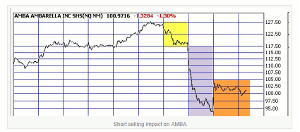Alan Ellman, of TheBlueCollarInvestor.com, highlights one of the issues that can impact an option position being held; short selling. Alan outlines the advantages and disadvantages to the short seller, charts the impact of short selling on a particular stock, and offers two possible exit strategies to consider.
Screening stocks and exchange-traded funds for covered call writing and put-selling involves evaluating for fundamentals, chart technicals, and common sense parameters. One of the issues that can impact a position we hold from time to time is short selling.
Definition
Short selling is when we sell a stock we don’t yet own. It is borrowed from our broker who lends it to us and then sells it. The proceeds are credited to our brokerage accounts as we now have an obligation to purchase the stock in the future to repay our broker. This is known as covering the short. We also must pay a fee to our broker for this transaction. The trade benefits when share price declines and loses when share price appreciates. Hedge funds are notorious for using this strategy as the leverage derived from generating cash for a small fee creates a potential for exponential returns for which hedge fund managers are well paid.
Advantages to the Short Seller
- Potential for large returns from a small investment
- Benefit in bear market environments
- Can be used as a portfolio hedge against market decline
Disadvantages to the Short Seller
- Dividends are collected by the broker (lender), not the short seller
- Risk is limitless if share price accelerates
- A positive development may trigger a short squeeze (a situation in which a heavily shorted stock moves sharply higher, forcing more short sellers to close out their short positions and adding to the upward pressure on the stock).
What Happened to Ambarella (AMBA) Over the Last Two Weeks?
AMBA has been a high flier since its IPO largely as a supplier to GoPro, the wearable camera maker. On Friday, June 19, short selling firm Citron Research published a negative report on AMBA triggering short sellers to take action and triggering a short-sale related circuit breaker to kick in when share price declined 10% from its previous day’s close. The implied volatility rose 27% to 70%, a one-year high. However, the put-call ratio remained even showing that investors were still undecided. Jim Cramer, on his Mad Money Show defended AMBA, claiming that it is an even better buy at these reduced prices.
Chart Showing Impact of Short Selling on AMBA
6/19/2015: Yellow field: Citron Research report made public
6/22/2015: Purple field: Short selling has major impact on share price
6/23/2015: Brown field: Share price recovery begins
Exit Strategy Opportunities
We must buy back options on 6/19 or 6/22. There is no doubt that near-the-money strikes have met our 20%/10% guidelines. Early contract strategies include waiting to hit a double (favored earlier in the contract) and rolling down. Of course, closing the long stock position and moving to another security is also available.
Discussion
This is a rare, but obviously possible, scenario where short selling has such a major impact on share value. The SEC and FINRA are keeping a close watch on potential market manipulation situations but we, as Blue Collar Investors, must be prepared for all possibilities. For those who still believe in this company as I do, may decide to continue to write out-of-the-money calls as share price recovers. For members who feel that this security is now too risky, it is time to move on to another stock. Many of us have enjoyed wonderful returns with AMBA since it was priced in the low $70s. Let’s watch the price action, especially compared to the overall market, as we move forward.
By Alan Ellman of TheBlueCollarInvestor.com






















